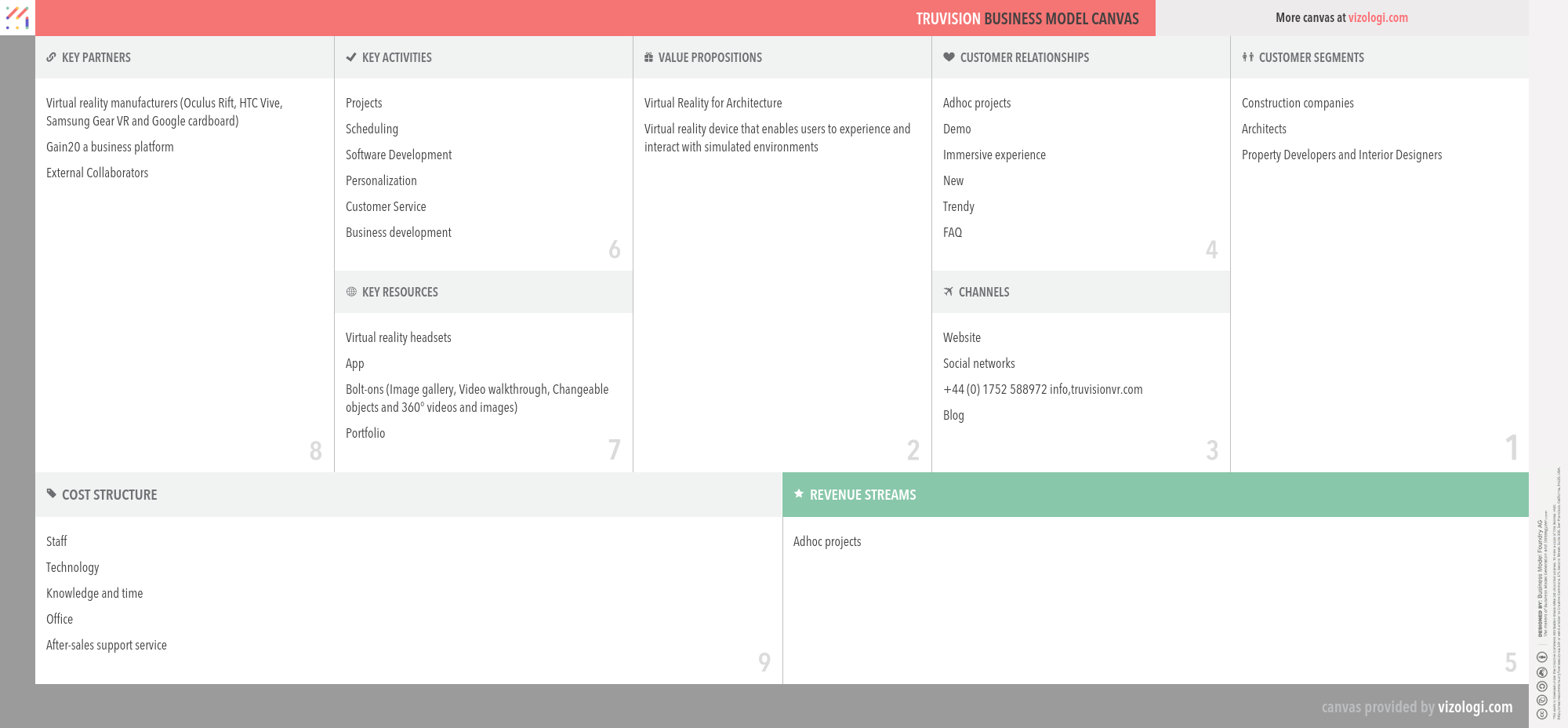Why TruVision's Business Model is so successful?
Get all the answers 
TruVision’s Company Overview
One of the UK’s leading virtual reality studios, provides high quality, quick turnaround and cost-effective VR solutions for the construction industry.
http://truvisionvr.comCountry: England
Foundations date: 2015
Type: Private
Sector: Consumer Services
Categories: Construction
TruVision’s Customer Needs
Social impact:
Life changing:
Emotional: design/aesthetics, attractiveness
Functional: reduces risk, saves time, quality, sensory appeal, integrates
TruVision’s Related Competitors
TruVision’s Business Operations
Codifying a distinctive service capability:
Since their inception, information technology systems have aided in automating corporate operations, increasing productivity, and maximizing efficiency. Now, businesses can take their perfected processes, standardize them, and sell them to other parties. In today's corporate environment, innovation is critical for survival.
Consumerization of work:
Consumerization of IT (consumerization) is a term that refers to the process by which Information Technology (IT) begins in the consumer market and then spreads to business and government organizations, primarily as a result of employees utilizing popular consumer market technologies and methods at home and afterward bringing them in the workplace.
Digital transformation:
Digitalization is the systematic and accelerated transformation of company operations, processes, skills, and models to fully exploit the changes and possibilities brought about by digital technology and its effect on society. Digital transformation is a journey with many interconnected intermediate objectives, with the ultimate aim of continuous enhancement of processes, divisions, and the business ecosystem in a hyperconnected age. Therefore, establishing the appropriate bridges for the trip is critical to success.
Experience:
Disrupts by offering a better understanding that customers are willing to pay for. Experience companies that have progressed may begin charging for the value of the transformation that an experience provides. An experienced company charges for the feelings consumers get as a result of their interaction with it.
Knowledge and time:
It performs qualitative and quantitative analysis to determine the effectiveness of management choices in the public and private sectors. Widely regarded as the world's most renowned management consulting firm. Descriptive knowledge, also called declarative knowledge or propositional knowledge, is a subset of information represented in declarative sentences or indicative propositions by definition. This differentiates specific knowledge from what is usually referred to as know-how or procedural knowledge, as well as knowledge of or acquaintance knowledge.
Product innovation:
Product innovation is the process of developing and introducing a new or better version of an existing product or service. This is a broader definition of innovation than the generally recognized definition, which includes creating new goods that are considered innovative in this context. For example, Apple launched a succession of successful new products and services in 2001?the iPod, the iTunes online music service, and the iPhone?which catapulted the firm to the top of its industry.
Solution provider:
A solution provider consolidates all goods and services in a particular domain into a single point of contact. As a result, the client is supplied with a unique know-how to improve efficiency and performance. As a Solution Provider, a business may avoid revenue loss by broadening the scope of the service it offers, which adds value to the product. Additionally, close client interaction enables a better understanding of the customer's habits and requirements, enhancing goods and services.
Virtual reality:
AR/VR is the fourth significant platform change (after PC, web, and mobile). First, CEOs must choose how to play. Business models are determined by installed bases, use cases, and unit economics; there is no one-size-fits-all answer; each situation is unique, and developers must do market research and analysis before making a choice. Relying on advertising-income is a handy strategy for unknown businesses or newcomers to the market. It allows them to use their prior expertise with mobile and online ad campaigns.
Recommended companies based on your search:

